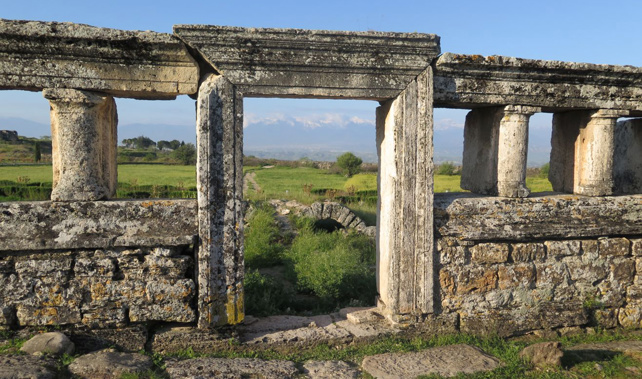
The Ancient Romans had a special affinity for hot springs and thermal baths. They established many of their main settlements, where such activity was identified, and one of the most striking settings is the hillside city of Hierapolis, perched above the calcite thermal terraces of Pamukkale, in Turkey. Hierapolis was a holiday hot-spot for Roman aristocrats, with marble colonnaded streets, high-end shopping and palatial thermal baths.
Its golden age was in the 1st and 2nd centuries AD, with an ever increasing number of temples, agoras and sanctuaries constructed. The main agora was one of the biggest shopping malIs in the world, 1800 years ago. It was a pleasure pad, complete with a ten thousand seater theatre, which has been triumphantly restored.
If you’re into your antiquities, Hierapolis is like a mini-Ephesus, an Ephesus for beginners. Like the amphitheatre, much of hillside-hugging Hierapolis has only been extensively excavated in the last few decades. As recently as the 1980s, a string of hotels were shamefully straddled the ancient ruins - causing huge damage. Thankfully, all those hotels have now been bulldozed, following Hierapolis securing World Heritage protection in 1988.
The restoration work is on-going, and an Italian archaeological team made a monumental discovery in the past few years, identifying the tomb of Saint Phillip. He was one of Christ’s apostles, an early Christian who came to Hierapolis, shortly after Christ’s death. The Romans considered his preaching as blatant mischief-making. When Phillip challenged the pagan snake-worshippers in the temple, the Romans collared him, and nailed him upside down, on the main city gate. One ancient story claims, as Phillip died, an abyss in the earth opened up, swallowing alive the Roman proconsul, the snake worshippers and 7000 unsuspecting bystanders! In the years that followed, a church was built over his tomb. Last year, Pope Francis accepted the findings of the Italian excavators, so Hierapolis is now an official new entrant on the Christian pilgrim trail.
Following the split in the Roman Empire, Hierapolis became a Byzantine city in 395AD, remained Pamukkale by the Ottoman Turks, many centuries later. The city was finally abandoned after a catastrophic earthquake seven hundred years ago. But adorning the main entrance to the old city is a vast necropolis, because the Romans thought siting the graveyard on the main road approaching a city, was the best way to venerate the dead. There are thousands of ornate tombs to explore, many of which contain the remains of ancient tourists, lured to Hierapolis by its much-touted curative waters, only to die here. Get here early in the morning, or late in the day, when the low sun gilds the scene spectacularly, backed by a natural soundtrack of bleating goats and birdsong.
Following a mega-earthquake in 1334, this fascinating ancient city was deserted, until the Ottomans set about revitalising the ancient Roman love affair with the thermal waters. Re-named Pamukkale, the Turkish word translates as “Cotton Castle. The enchanting name was clearly inspired by the spell binding natural formation of the cascading calcite terraces, over-running with hot, mineral-rich water from the thermal springs. Calcuim and hydrogen carbonate react to create calcium carbonate ( also known as travertine) and limestone, which produces Pamukkale’s chalky white terraces. You could wallow all day in these soothing terraces. It is prohibited to wear shoes in the terrace pools to protect the deposits. From a distance, it looks a hanging glacier on the hillside, or huge mounds of cotton candy strung along the cliffs. It’s one of Turkey’s singular experiences, and a dazzling spectacle, for even the most jaded of travellers. For Kiwis, Pamukkale is a brutal insight into how wondrous our once famed Pink and White Terraces must have been, before Tarawera destroyed them so violently.
Just upstream from the gleaming white calcite terraces, one of the oldest known Roman baths still operates, two thousand years later as a thermal pool. Aptly called the antique pool, it’s surrounded by Roman ruins, and you can have a soak in the same pool that Cleopatra bathed in, en-route to Ephesus in 41BC, with Mark Antony. Fast forward to the Ottoman Empire, and traders on the Silk Road to China would also pull up in their caravans, for a quick roadside dip.
TOP TIPS.
Pamukkale is an appointment destination, in southwestern Turkey’s inner Aegean. The easiest way to get there is from the coastal hotspot of Kusadasi. It’s a 3 hour drive away, so jump on a bus for a day trip, or overnighter.
Think Turkey and hot-air ballooning and you could well conjure an image of Cappadocia. But an early morning balloon ride over Hierapolis and the travertine terraces is an exceptionally spectacular way to marvel at the time-honoured majesty of the area.
Mike Yardley’s is Newstalk ZB Travel Correspondent on Jack Tame Saturdays. 11.20am
Take your Radio, Podcasts and Music with you









